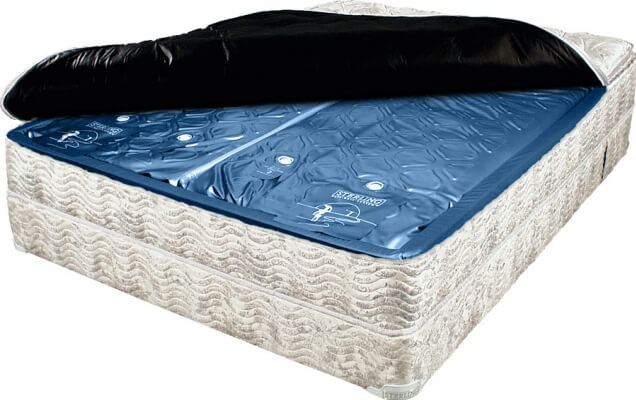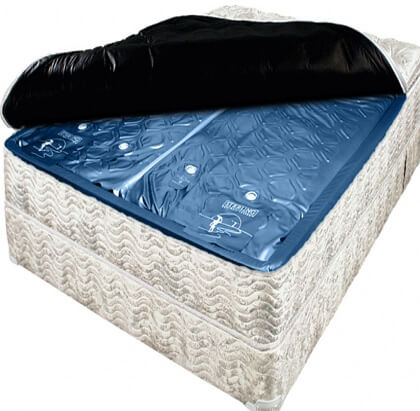Every purchase made online is encrypted with a high level of security you’ve come to expect. Your private information is never shared nor sold, so you can buy with confidence. You can also visit our store if you are in the St. Louis area.

Estimated reading time: 7 minutes
Many purists do not consider a Tube Type Waterbed a true Waterbed rather they consider it a hybrid waterbed. This blog post highlights the ten problems and benefits of tube or cylinder-type softside waterbeds.
Table of Contents
Here Are The Top Ten Problems With Tube Or Cylinder Type Softside Waterbeds
Related Links
- Tube beds do not feel like a deep-fill waterbed.
It does not form to the body the way waterbeds that are 7 inches or deeper do. Deep fill waterbeds are much better at relieving pressure points on the body and decreasing tossing and turning than tube beds. - Softsided systems like the tube bed are usually too firm for most waterbed lovers.
They can feel as firm as a regular spring mattress, not providing the same head-to-toe full-body support as a waterbed. - Tube-type waterbeds usually are not heated.
Adjustable heat is the one thing most waterbed owners want yet many tube beds don’t have them. Most tube type waterbeds are designed with a thicker top cover to insulate and eliminate the need for a heater. If a heater is used it must be a low-watt heater to keep the bed from overheating or even possibly burning out. - Trying to find where the leak is located.
With 8 tubes in a Queen mattress and 10 in a King mattress, each must be examined very closely. Many times it is one of the 8 or 10 caps and plugs that can leak and they must be replaced. If the leak is found in the vinyl of the tube, we recommend replacing the tube. Repairing in tubes can be tricky because leaks are usually in high-stress areas due to their design. It is common for them to fail around a seam or the valve making it nearly impossible for a patch to stick and contain water. - Tubes/cylinders are awkward and hard to fill.
Tubes are usually filled in an area close to a water source and then carried into the bedroom and placed in the bed. Each tube should be filled to the same level. This means holding the 60 to 100 lb. tube erect which is very heavy and very awkward and filling to the fill mark on the tube itself. This is contrary to the sales pitch many sales associates provide suggesting that they are easy to fill, drain, and move. These same people usually have never installed one in a customer’s house much less attempted to fill and get the water level precisely the same so comfort is not affected.. - Lack of core support from the multiple water mattresses
Look at the fingers on your hand and tightly pull them together. This is a simplified demonstration of the core support in a tube bed. The gaps in your fingers are no different from the gaps in the tubes that are lacking to properly support the sleeper. Overfilled tubes exaggerate the problem and layers of foam in the cover disguise the problem. - Top covers can and do break down quickly.
One of the most common problems next to tube failure in these water-log-designed beds is that the cover of the mattress breaks down. Mattress covers are overfilled with materials to insulate sleepers from what is usually considered a nonheated waterbed. They usually have 4” or more of padding and foam and frequently break down and compress much like a fluffy pillow top mattress not to mention these top covers are not standardized or cheap to replace. - Finding the right size replacement tubes can be tricky.
Tubes are not standard in length and must be the correct length or they will rupture at the end seams of the bed. Some tubes are round while others are more squared off. Always take the old tube with you when you are shopping for a replacement tube to make sure you’re replacing it with a proper replacement.. - Baffled or fiber-filled tubes can be very hard to drain.
This baffling is usually an open-cell foam. This foam acts like a giant sponge making them hard to extract the water from. If the baffled tubes are not handled carefully the foam can be torn. It can also shift out of its correct position or get balled up inside the tube. These tubes can cost up to 50% more than a free slow tube to replace. - Free-flow tubes don’t have a very long life expectancy.
These cylinders tend to give the bed a bucking motion. The water races the length of these tubes when pressure is exerted on the opposite end, which stresses the end seams and can cause a seam failure.

Top Ten Benefits Of A Tube Softside Waterbed
1. Tube or Cylinder beds look and make like a regular mattress and box springs.
This might seem obvious but people choose tube soft side water beds because they use sheets and bedding found at any store in all the familiar sizes. They even adapt to conventional beds but do not look like a 1970s water bed
2. Softside Tube Waterbeds weigh less
A big complaint of flotation beds is the waterbed weight, which can go as high as 2000lbs in a king-size Hardside Waterbed. However, a king-size tube bed can weigh in at only about 700-800lbs. Most are in the 4” depth range whereas a deep fill soft side can range from 6”-13” with 7”- 8” being the most common cavity depth.
3. Moving a Tube Waterbed is much easier than traditional waterbeds.
With 10 tubes in a king and 8 in a queen, the individual tubes weighing 60-80 lbs can be removed from the bed without being drained and moved as individual pieces.
4. Easy to assemble.
You just put the foundation and the shell of the softside tube bed on a proper bed frame and lay the individual tubes in it. If the bed is not quite where you want it just remove the tubes slide the bed to where you want it and place the tubes back into it with no draining or filling.
5. Filling tubes does require running a garden hose through the house.
You can fill your tube in another location such as a bathroom or outside so you don’t have to worry about spilling water in the bedroom.
6. Delivering the bed with the tubes already filled.
This makes for a quick delivery and no worrying about a water source in the customers’ home.
7. You can adjust mattress firmness.
Varying the amount of water put in the tubes can change the feel of the mattress or firmness from side to side. Baffled tubes can be purchased that can stop the motion and make the bed much firmer.
8. Determining which tube leaks is easy and replacing it is even easier.
Usually, if a tube has been leaking one of them will have less water than the others. Simply repair or replace the bad tube. 1 Free flow tube costs $20-$30 and baffled tube can cost up to $40. Replacement waterbed bladders for a deep-filled bed can cost hundreds of dollars.
9. Does not require a waterbed heater.
An extra thick cover is used to insulate them. If a heater is used it must be a low-watt heater made specifically for a shallow fill or tube bed.
10. Tube waterbeds cost less.
This is not always the case but tube beds generally speaking usually offer a firmer feel for less money than a deep-fill baffled mattress.
Conclusion
Somma is probably the most recognizable brand name for tube beds sold. Don’t get us wrong many people have enjoyed these beds over the years, however, our 24-plus years of handling their service issues is the reason we are not big fans of their design. At STL Beds we have limited our sales of them and even removed them from our showroom floor. Their high failure rate, lack of support, durability, and the fact that they feel nothing like a true waterbed puts them at the bottom of our recommendation list.
Our suggestion is to consider a true deep fill softside waterbed. If your response is that tube waterbeds don’t feel like a waterbed then I think you can see why we believe the tube bed is a hybrid bed with a lot of troublesome issues making nearly any other mattress a better option.
Contact STL Beds Now
You can also contact us by filling out the form below. Make sure to fill in as many fields as possible so we can respond to you with the most accurate information!
